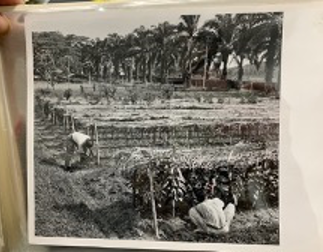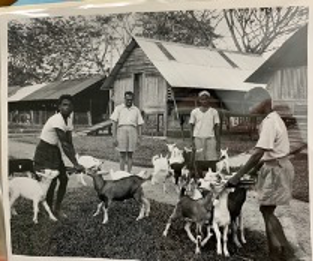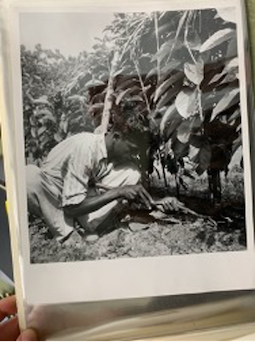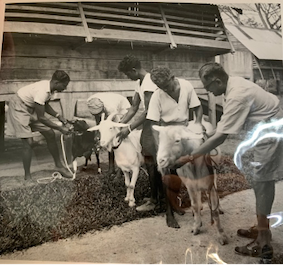In January 2020, I accidentally came across a series of photographs at the UK National Archives documenting agricultural and livestock experimentation in 1930-1940s British Malaya. The peculiarity of these photographs was striking. British Malaya was infamous for a rigid racial division of displaced and relocated labor in the service of colonial extraction, with Chinese laboring in tin mines and Indians working on plantations. The Malays, indigenous communities of Malaya, were marginalized from colonial extractive industries based on the racialized myth of the “lazy native,” depicted as cultivators of padi (rice fields). Instead, these photographs depicted Indian, Malay, and Chinese as farmers or agricultural assistants operating in different sectors of the small-scale “native” agriculture of Malaya. These photographs aim to capture agricultural and livestock improvement techniques, such as plot flattening, budgrafting, or interbreeding, and are most often succinctly described in reference to food productivity, profitability, and technical innovation in the field of small-scale agrarian and animal husbandry practices.
How did the tight division of labor underpinning industrial extraction in the early days of British Malaya morph into the inter-racial professionalization of small-scale agricultural practices? Also, in light of recent Anthropocene-related debates that negotiate the specificities of Anthropos as species within ecologies of disruption (Hecht 2018), how do capitalist-scientific interventions into matter complicate convenient narratives of a nature-culture divide? How do such interventions in Malaya engender material localities with biopower to (re-)produce life along with predetermined extractive logics?
With the Covid-19 pandemic restricting all possibilities for ethnographic fieldwork, I headed to the UK in 2021 to conduct further archival research. As I outline in my preliminary findings below, I note that discussions on agricultural and livestock experimentation in the 1930s underscore both a critical rethinking of colonial management in the British Empire and a turning point for the administration of Malaya. The new imperial agricultural policy of securing food self-sustainability, enhancing soil fertility, and developing the colonies focused on marrying improved livestock to land through manure. In Malaya, this systematic livestock-land approach to “native agriculture” operationalized local racial hierarchies towards a capitalist re-inscription of species. For the British, successful race-specific livestock interbreeding in Malaya was supposed to deliver exactly the good shit that a productive “native” agriculture needed.

“Malaya Agricultural Research. Deerlike Bali cattle are being used for breeding purposes at the station.” British Official Photograph: Issued by the central office of information, London. Crown Copyright Reserved. Reference Number D. 72357.
Manure as Panacea for Productive Native Agriculture
In the 1930s, British agricultural policy was refocused throughout the empire in response to the rising prices of food imports, innovations in the science of agriculture and growing anti-colonial sentiments. In a departure from the manipulation of science towards commodity-based research and the export-oriented colonial economy, the new policy focused on conserving the empire’s natural resources, redefining rural development and land utilization, and managing local agricultural practices (Clarke 2018). This revised policy appointed the Colonial Advisory Council on Agriculture and Animal Health (CACAAH) which co-opted renowned scientists and employed the “system approach” of the Oxford School of Ecology, wherein it aimed to “ground the imperial mission on a scientific basis through the use of systematic planning, co-ordination and resource management” (Hodge 2002, 15-16). At its heart, CACAAH’s systematic approach to small-scale agriculture in the colonies relied on marrying improved livestock to land through manure. For the British, animal waste emerged as the panacea for the management of soil fertility, crop diversification, and successful mixed farming (Hodge 2011).

Malaya. Pig and Fish Farm. Feeding piglets with raw kang kong. British Official Photograph: Issued by the central office of information, London. Crown Copyright Reserved. Reference Number D. 72524.
In line with the revised imperial policy on agriculture, British Malaya pushed harder for the reorganization of ‘native’ agriculture. The British framed ‘native’ agriculture in Malaya as a failure right from the very beginning, as they justified extractive colonialism through the racialized myth of the ‘lazy native’ (Hirschman 1986). As the 1919 Department of Agriculture Report outlined, the British needed a thriving native agriculture sector and a resident peasantry (Kratorska 1985) to feed the rubber and tin industries’ workforce and to cut down the cost of food supply throughout the colony. Although attempts at boosting the productivity of Malay padi cultivators started in the early 1900s, these proved futile: “under native management, padi was not a profitable crop” because while “the Malays are an agricultural race, (…) they lack the agricultural instinct” (Arman et al 2014, 4).
Events in the 1920s exacerbated this perceived agricultural crisis. The First World War and the Great Depression exposed British Malaya’s dependency on imported foodstuffs, especially rice, as a critical vulnerability. This called for securing food self-sufficiency and reducing colonial dependence on imported foodstuffs, enhancing land fertility, and improving native agricultural methods. Efforts towards thriving native agriculture galvanized in the late 1920s when, in addition to opening the very first School of Agriculture, High Commissioner Hugh Clifford took executive steps towards the “systematic and orderly settlement of [Indian, Chinese, and Netherland East Indies Malays] migrants on newly opened lands” (Kratorska 1982, 302). By 1932, the colonial government had issued over 50,000 temporary occupation licenses (TOL), the permanent settlement of Indians and Chinese laborers as another potential source of permanent peasantry (Ghee 1971; Mehmet 1977).
Infertile soils and erosion, urgent albeit imagined matters (Williamson 2018), were also cited as the main factors influencing Malayan agriculture. The “poverty” of soils in Malaya, a colonial fabrication that conflated ‘lazy natives’ with the land, impacted both the profitability of cultivated crops, such as rice and fruit trees and the variety of crops that could be cultivated. In 1939, O.T. Faulkner underscored farmyard manure as a panacea for native agriculture in Malaya: “the improvement in peasant agriculture is bound up with the keeping of livestock and making manure”. Livestock and the resultant farmyard manure were supposed to contribute to native agriculture in three key ways: fertilizing the soil, diversifying the range of crops cultivated in Malaya, and assisting the transition to a mixed farming system. However, the British weren’t satisfied with just any kind of shit. It was improved animals that would produce the manure needed to grow improved nutrition, namely fodder crops. This whole systematic approach would gear the bourgeoning Malayan peasantry towards mixed rotational farming, thus eventually boosting both productivity and profitability.

“Malaya. Agricultural Research. The seedlings plot of the budgrafting area.” British Official Photograph: Issued by the central office of information, London. Crown Copyright Reserved.
Improved Livestock as “Racialized Assemblages”
While the establishment and rationale of improved livestock experimentation were not unique to British Malaya, its modus operandi lay firmly within the colony’s racial hierarchy. Operationalized by the British as a “technology of extraction” (cf. Yusoff 2018, 15), race became the main currency mediating the extractive economies, regimes of labor, and political assemblages in British Malaya (Ong 1987; Milner 2008). Livestock experimentation in Malaya, then, sits squarely at the intersection of colonial anxieties over foodstuff and growing unemployment, imperial fantasies of fertile soils, and attempts at rationalizing ‘racialized assemblages’ (cf. Weheliye 2014) of human and more-than-human actors into the genre of liberal humanism.

“Malaya Agricultural Research. Kids imported from England. They will be used for crossing with local small varieties to produce larger breeds.” British Official Photograph: Issued by the central office of information, London. Crown Copyright Reserved. Reference Number D. 72563.
In 1939 the Agricultural Adviser in Malaya observed that “there was no livestock production industry in Malaya, but rather a series of totally distinct industries which have no points of contact with each other (…) largely unchangeable, bound up as it is with racial, religious and political considerations.” Any development policy, he argued, “should be framed to fit the situations [and] cater for the tastes and habits of the people”. The Malays held and the ‘kampong’ fowl which was described as a “nondescript squawking wild, undersized, low producing type of bird”. Sikhs and Tamils had milk cows and milk buffaloes, as well as occasionally goats which were kept exclusively for the mutton market while also “occasionally milked either by the more optimistic type of owner or by the less intelligent type, both types showing a lack of perspective by expecting a goat on a strictly limited diet to provide surplus milk”. The Chinese diaspora cared for pigs and poultry, the latter being considered “vastly superior to the Malay kampong fowl both as a producer of eggs and as a table bird.”
This race-specific categorization of breeds and species undertaken by the British in Malaya hinged upon the inscription of racialized difference and hierarchy on the spectrum of being. Biocentrism, the cultural coding of the White, rational, bio-centric, political, and optimally economic subject of the state, i.e. human-as-Man, is underwritten by race. Biocentrism projects a color line on the entire spectrum of biotic and abiotic life, marking a space of Otherness populated by the dysselected and downtrodden (Wynter 2003). Science, then, is predicated upon biocentrism, produced as an ‘objective system of knowledge’ that indexes difference and hierarchy within the descriptive framework of liberal humanism. (McKittrick 2015, 145).

“An agricultural assistant budgrafting fruit received from out-station onto seedling stock. When the budgraft has grown out of the seedling’s stem as a new tree, the original seedling is pruned just above the juncture and the new fruit is born.” British Official Photograph: Issued by the central office of information, London. Crown Copyright Reserved.
Colonial management of the livestock production industry in Malaya imagined animal interbreeding as improved race-specific enterprises. The Malays’ buffaloes had to be improved for increased milk production capacity by “importing from India already improved male and female animals of tropical breeds”. Similarly, local cattle were to be improved with imported Indian cattle. In terms of poultry, improved stock suggestions focused on “the possibility of first replacing the existing Malay kampong fowl by the relatively hardy Chinese Canton breed (…) so preparing the ground for the final stage of introducing pure bred Rhode Island Red”. Chinese poultry, in turn, was to be improved by importing “large numbers of say Rhode Island Red eggs by air from disease-free farms in Australia and England” and distributing these across local Chinese hatcheries. Colonial administrators suggested the improvement of Chinese swine with British breeds of boars, adding that “upgrading with European boars may prove the best procedure but this will depend on adequate supplies of food being available for fattening rapidly maturing animals”. Race served not only as a technology of extraction but also as a technology of scientific re-inscription.
Scholars conceptualize experiments as technical and conjunctural future-making assemblages that simultaneously shape life forms, i.e. living organisms, and forms of life, i.e. ways of life. (Murphy 2017; Porter 2019; Helmreich 2009). Experimentality in the context of capitalism hails life as composed of the possibility of becoming and of the “manipulable relations that can be triggered and altered” within the “forms and phantasies of economization” (Murphy 2017, 81). Discussing experiments in family planning in the 1970s in Bangladesh, Murphy notes that neoliberal experimentality was “premised on a sense of the world as generative not despite but because of its precarity” (Murphy 2017, 90).

“Malaya Agricultural Research. A large male goat, imported from England, pictured with a tiny local female and a specimen of the larger variety which is the result of the cross-breeding the two.” British Official Photograph: Issued by the central office of information, London. Crown Copyright Reserved. Reference Number D. 72385.
Along these lines, agricultural and livestock experimentations in British Malaya emerged as interfaces for modulating life forms along with the biocentric coordinates of human-as-Man not despite the dysselection of racialized colonial subjects, but because of it. In this way, hybrid breeds of animals were cultivated towards self-containment and standardization within their respective species-race nexus, such as swine-Chinese, cattle-Indian, poultry-Malay, and Chinese or goats-Indian, but as political and economic subjects of empire. Essentially, their operation and re-production within their species-race-specific boundaries were meant to enable the self-re-generation of capitalism (Tsing 2012) and the replication of liberal humanism in the absence of governing imperial power, simply “because it appears to be the natural thing to do” (KcMittrick 2015, 147).
Entangled Histories of Becoming – Also, an Inconclusive Conclusion
The archive, as Ariella Azoulay (2020) notes, constantly produces and reproduces a life of no return. In its self-legitimating style of documenting, the archive presents the document as an ontological fact, thus negating any attempts for a reparative history. In their future-oriented re-generation of life forms and forms of life, experiments also contain a significant degree of unpredictability. The inherent malleability of life forms that become entangled gestures towards the possibility of unprecedented, perhaps even accidental, modes of relationality. Considering Azoulay’s invitation to archival re-reading, I wonder what might emerge from a Malay, Indian, Chinese or Malaysian annotation and redaction (cf. Sharpe 2016) of these documents? What forms of life and life forms, in their most intimate or casual occurrences, are rendered absent, invisible, and which sit, insurgently, in plain sight? What place-specific relationalities and collaborative practices across the spectrum of being develop in excess of the indexes of biocentrism in British Malaya?
This post is part of the series “(Re)Assembling Asias through Science.” Click here to read the series’ introduction and contact editors Chunyu Jo Ann Wang (chunyuw@stanford.edu) and Tim Quinn (quinnt@rice.edu) if you are interested in contributing!
Acknowledgments
I would like to thank the Robert F. and Jean E. Holtz Center for Science and Technology Studies, the Center for Southeast Asian Studies, and the Anthropology Department at the University of Wisconsin-Madison for their generous support that made this research possible. Also, I would like to express my gratitude to contributing editors Tim Quinn, Chun-Yu (Jo Ann) Wang, and Eduard Fanthome for their enthusiasm, support, and thoughtful suggestions. Finally, a big thanks to Patty Lan who helped me refine my thoughts and writing for this post.
References
Gabrielle Hecht, 2018, “Interscalar Vehicles for an African Anthropocene: On Waste, Temporality, and Violence,” Cultural Anthropology 33(1).
Kathryn Yusoff, 2018, A Billion Black Anthropocenes or None, Minneapolis: University of Minnesota Press.
Charles Hirschman, 1986, “The Making of Race in Colonial Malaya: Political Economy and Racial Ideology,” Sociological Forum, 1(2).
Paul H. Kratorska, 1985, “The Peripatetic Peasant and Land Tenure in British Malaya,” Journal of Southeast Asian Studies, 16(1).
Paul H. Kratorska, 1982, “Rice Cultivation and the Ethnic Division of Labour in British Malaya,” Comparative Studies in Society and History 24(2).
Ezwan Arman et al., 2016, “Agricultural education as a medium for the transmission of Western science during British rule in Malaya,” History of Education.
Lim Teck Ghee, 1971, “Peasant Agriculture in Colonial Malaya: Its Development in Perak, Selangor, Negri Sembilan and Pahang, 1874-1941,” (PhD Dissertation, Australian National University, Canberra).
Ozay Mehmet, 1977, “Colonialism, Dualistic Growth and the Distribution of Economic Benefits in Malaysia,” Southeast Asian Journal of Social Science, 5(1).
Sylvia Wynter, 2003, “Unsettling the Coloniality of Being/Power/Truth/Freedom: Towards the Human, After man, Its Overrepresentation – An Argument,” CR: The New Centennial Review, 3(3)
Katherine McKittrick, 2015, “Axis, Bold as Love: On Sylvia Wynter, Jimi Hendrix, and the Promise of Science,” in Katherine McKittrick (ed.), Sylvia Wynter: On Being Human as Praxis, Durham: Duke University Press.
Sabine Clarke, 2018, Science at the End of Empire: Experts and the Development of the British Caribbean, 1940-1962, Manchester: Manchester University Press.
Michelle Murphy, 2017, The Economization of Life, Durham: Duke University Press.
Natalie Porter, 2019, Viral Economies: Bird Flu Experiments in Vietnam, Chicago: University of Chicago Press.
Stefan Helmreich, 2009, Alien Ocean: Anthropological Voyages in Microbial Seas, Berkeley: University of California Press.
Anna Tsing, 2012, “On nonscalability: the living world is not amenable to precision-nested scales,” Common Knowledge 18(3).
Ariella Azoulay, 2019, Potential History: Unlearning Imperialism, London: Verso.
Katherine McKittrick, 2021, Dear Science and Other Stories, Durham: Duke University Press.
Christina Sharpe, 2016, In the Wake: On Blackness and Being,” Durham: Duke University Press.
Aihwa Ong, 1987, Spirits of Resistance and Capitalist Discipline: Factory Women in Malaysia, Albany: SUNY Press.
Anthony Milner, 2008, The Malays, Oxford: Blackwell.
Fiona Clare Williamson, 2018, “Malaya’s greatest menace? Slow-onset disaster and the muddy politics of British Malaya, c. 1900-50,” International Review of Environmental History 4(2).
Joseph Hodge, 2002, “Science, Development and Empire: The Colonial Advisory Council on Agriculture and Animal Health, 1925-1943,” The Journal of Imperial and Commonwealth History 30(1).
